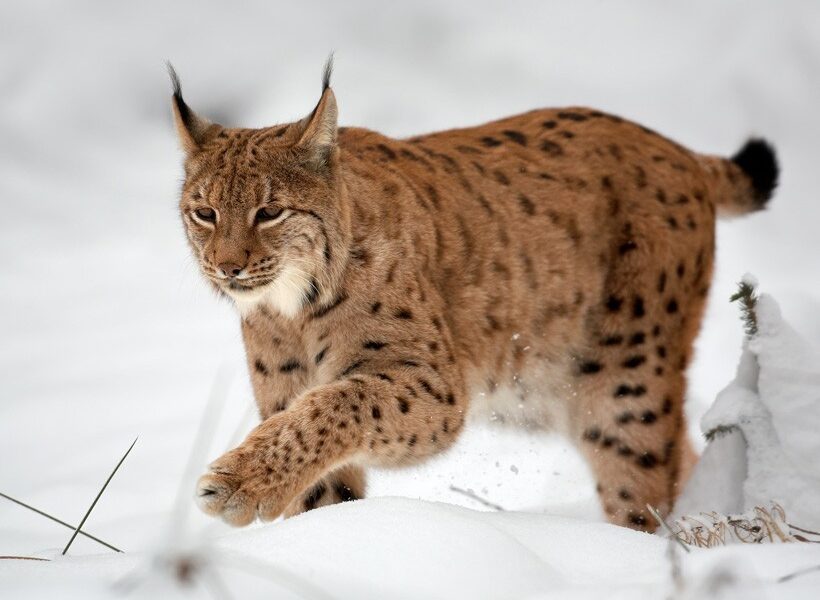The Eurasian lynx (Lynx lynx) is a fascinating medium-sized wildcat with a unique blend of adaptability, stealth, and beauty. Known for its tufted ears, striking coat patterns, and exceptional hunting prowess, this elusive predator is vital to the ecosystems it inhabits. Found across Europe and Asia, the Eurasian lynx has a story worth exploring.
In this blog, we’ll dive deep into the Eurasian lynx’s habitat, behavior, taxonomy, conservation status, and more. Whether you’re a wildlife enthusiast, conservationist, or simply curious about this extraordinary animal, this guide is your ultimate resource.
Table of Contents
- Overview of the Eurasian Lynx
- Physical Characteristics
- Distribution and Habitat
- Subspecies of Eurasian Lynx
- Behavior and Hunting Strategies
- Reproductive Patterns
- Predator-Prey Dynamics
- Conservation Status and Efforts
- Testimonials
- FAQs

Overview of the Eurasian Lynx
The Eurasian lynx is one of four species in the genus Lynx. It holds the title of the largest among its relatives, with its range spanning Northern Europe to the Tibetan Plateau. Despite its widespread presence, this remarkable species faces threats such as habitat loss, poaching, and prey depletion.
Key Facts About the Eurasian Lynx
| Characteristic | Details |
|---|---|
| Scientific Name | Lynx lynx |
| Local Name | Eeh |
| IUCN Status | Least Concern |
| WLPA 1972 Classification | Schedule I |
| Average Weight | 15–29 kg (males are 25% heavier) |
| Head & Body Length | 80–110 cm |
| Tail Length | 16–23 cm |
Physical Characteristics
The Eurasian lynx is a striking creature, with distinctive features that set it apart:
- Coat and Fur: Its sandy-grey coat is adorned with dark spots and rosettes, varying in intensity based on location. Winter fur is denser and can range from silver-grey to greyish-brown.
- Ears and Tail: Long black tufts up to 6 cm crown its ears, while its short tail with an all-black tip gives it a unique appearance.
- Build: The lynx’s long legs, particularly the rear ones, provide a tilted-forward stance. Its large, webbed paws act like snowshoes in snowy terrains.

Distribution and Habitat
Europe
- Scandinavia: After near extinction in the 1930s, populations in Sweden, Norway, and Finland have steadily recovered. Controlled hunting and conservation efforts have been pivotal.
- Western Europe: Once extinct in Germany, lynxes were reintroduced in the 1990s. Similarly, Switzerland saw successful reintroductions in the Alps and Jura Mountains.
- Eastern Europe: Countries like Poland, Slovakia, and Romania host thriving populations, particularly in the Carpathian Mountains.
Asia
- Central Asia: Found in Kazakhstan, Kyrgyzstan, and Mongolia, these lynxes adapt to forest-steppe ecosystems.
- Himalayan Region: Regions like Ladakh and Himachal Pradesh in India harbor lynxes above altitudes of 3,500 meters.
Subspecies of Eurasian Lynx
Over time, scientists have identified various subspecies of the Eurasian lynx, each adapted to specific environments.
| Subspecies | Distribution |
|---|---|
| Northern lynx (L. l. lynx) | Fennoscandia, Baltic states, and Western Siberia |
| Turkestan lynx (L. l. isabellinus) | Central Asia, including Ladakh and Tibet |
| Siberian lynx (L. l. wrangeli) | Russian Far East and Kamchatka Peninsula |
| Balkan lynx (L. l. balcanicus) | North Macedonia, Albania, and surrounding regions |
| Carpathian lynx (L. l. carpathicus) | Carpathian Mountains spanning Romania and Slovakia |

Behavior and Hunting Strategies
The Eurasian lynx is primarily nocturnal or crepuscular. Solitary by nature, these cats maintain expansive hunting ranges using scent marks to establish territory.
Diet and Hunting
- Prey Preference: Small to medium-sized mammals like hares, marmots, and deer dominate their diet. In Estonia, a lynx may kill up to 60 roe deer annually.
- Adaptability: When smaller prey is scarce, lynxes pivot to larger ungulates like reindeer and red deer.
- Hunting Techniques: Ambush predators by design, they rely on stealth and precision, often climbing elevated spots to scan their surroundings.
Reproductive Patterns
Breeding Season
- January to April marks the mating season, with females entering oestrus for about a week.
- Gestation lasts approximately 67–74 days, culminating in the birth of 2–3 kittens.
Parental Care
- Dens are carefully constructed with protective features and lined with soft materials.
- Kittens remain with their mothers until around ten months old, learning vital survival skills.
Predator-Prey Dynamics
Despite being a top predator, the Eurasian lynx faces challenges from other carnivores like wolves and wolverines.
- Competition: In regions like Russia’s taiga, red foxes and eagle owls vie for similar prey.
- Cannibalism: Documented in Anatolia, this rare behavior often involves sub-adult lynxes.
- Predators: Siberian tigers and Amur leopards occasionally prey on lynxes in overlapping territories.
Conservation Status and Efforts
The Eurasian lynx is classified as “Least Concern” by the IUCN, but its survival depends on ongoing conservation efforts.
Key Conservation Measures
- Protected Status: Listed in Appendix II of CITES and Appendix III of the Berne Convention.
- Reintroduction Projects: Successful programs in Switzerland and Germany are models for other regions.
- Challenges: Habitat fragmentation and illegal hunting remain significant threats.

Testimonials
“Seeing a Eurasian lynx in the wild was a dream come true! Their elegance and stealth are unparalleled.”
“As a conservationist, I admire the efforts taken to reintroduce the Eurasian lynx. Their role in maintaining ecological balance is crucial.”
FAQs
Q1: Where can I spot a Eurasian lynx in the wild?
A: National parks in Scandinavia, the Carpathian Mountains, and Ladakh in India are prime locations.
Q2: What is the diet of a Eurasian lynx?
A: They primarily prey on hares, deer, and birds but may hunt larger ungulates in winter.
Q3: How are conservationists helping the Eurasian lynx?
A: Through reintroduction projects, habitat preservation, and strict anti-poaching laws.
Q4: Why are ear tufts significant for lynxes?
A: The tufts enhance hearing and communication, vital for their survival.
Q5: How long do Eurasian lynxes live?
A: They live up to 21 years in captivity and slightly less in the wild.








